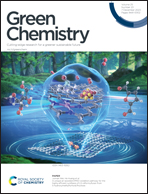Recent developments in polysaccharide and lignin-based (nano)materials for CO2 capture
Abstract
Global warming in 2023 shows no signs of slowing down. The situation alarms scientists, including the Intergovernmental Panel on Climate Change, the international body responsible for regularly developing knowledge on climate change. Indeed, some impacts are already threatening the environment. Today, the average global temperature has increased by about 1 °C compared to the pre-industrial era (1850–1900). At the current rate, the increase in global average temperature will reach 1.5 °C between 2030 and 2052. The greenhouse effect is unbalanced by human activities, in particular the use of fossil fuels (oil, gas, and coal), which lead to the release of greenhouse gases. CO2 represents nearly 2/3 of global greenhouse gas emissions caused by human activities and has the tendency to linger in the atmosphere for a long time. This is why the effect of other greenhouse gases is usually measured in CO2 equivalent. Current CO2 emissions will impact atmospheric concentrations and global temperatures for decades. To date, some solutions have been proposed to deal with this (energy transition, regulation of emissions, etc.). However, most of these solutions have not yet been sufficiently developed and/or do not offset the effects of ever-increasing industrialization on anthropogenic CO2 emissions. As a result, carbon capture and sequestration processes appear to be attractive solutions. CO2 capture can take place by absorption (chemical and/or physical) and/or adsorption (chemisorption and/or physisorption). Various compounds can act as sorbents, among which polysaccharides and lignin have special importance due to their many advantages, the most important of which are biodegradability, availability, relatively cheapness, environmental friendliness, etc. In this review, we report recent studies regarding polysaccharides and lignin-based materials for CO2 capture. Such materials can be in different forms such as composites, aerogels, hydrogels, pellets, heteroatom-doped materials, membranes, metal–organic frameworks (MOFs), porous carbons, etc. These materials are used for CO2 capture through the adsorption or absorption processes.

- This article is part of the themed collections: Celebrating International Women’s day 2025: Women in green chemistry and 2023 Green Chemistry Reviews


 Please wait while we load your content...
Please wait while we load your content...